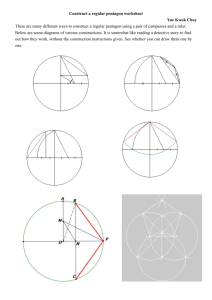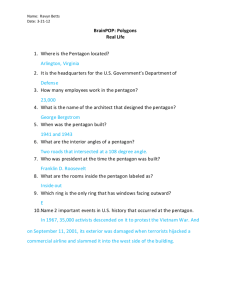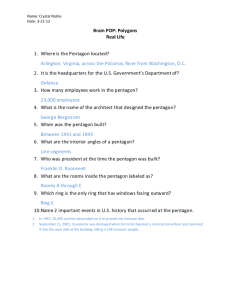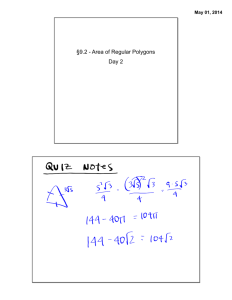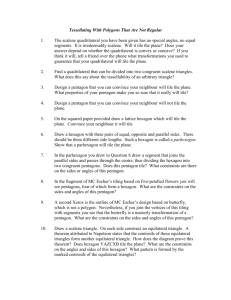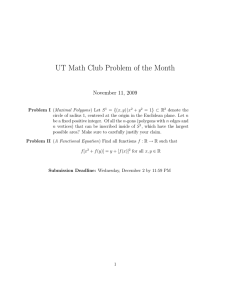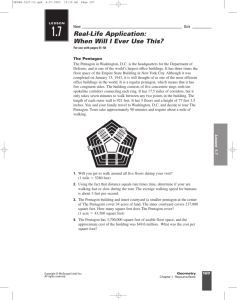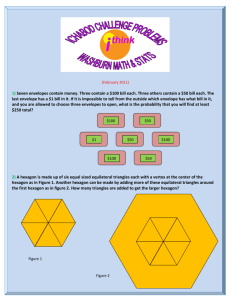Document 14303957
advertisement
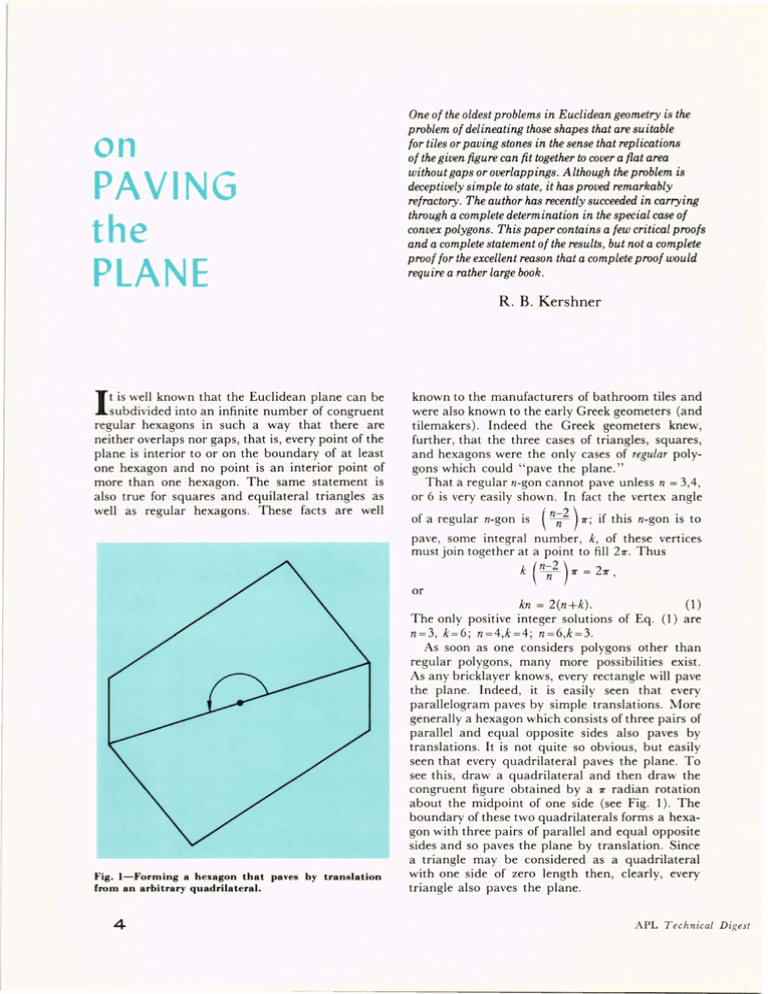
on PAVING the PLANE One of the oldest problems in Euclidean geometry is the problem of delineating those shapes that are suitable for tiles or paving stones in the sense that replications of the given figure can fit together to cover a flat area without gaps oroverlappings. Although the problem is deceptively simple to state, it has proved remarkably refractory. The author has recently succeeded in carrying through a complete determination in the special case of convex polygons. This paper contains a few critical proofs and a complete statement of the results, but not a complete proof for the excellent reason that a complete proof would require a rather large book. R. B. Kershner I t is well known that the Euclidean plane can be subdivided into an infinite number of congruent regular hexagons in such a way that there are neither overlaps nor gaps, that is, every point of the plane is interior to or on the boundary of at least one hexagon and no point is an interior point of more than one hexagon . The same statement is also true for squares and equilateral triangles as well as regular hexagons. These facts are well known to the manufacturers of bathroom tiles and were also known to the early Greek geometers (and tilemakers). Indeed the Greek geometers knew , further , that the three cases of triangles, squares, and hexagons were the only cases of regular polygons which could " pave the plane." That a regular n-gon cannot pave unless n = 3,4, or 6 is very easily shown. In fact the vertex angle o f a regu Iar n-gon .IS ( -n-2 -n ) 7r; 1'f t h'IS n-gon .IS to pave, some integral number, k, of these vertices must join together at a point to fill 27r. Thus k (n~2 ) 7r = 27r , or Fig. I-Forming a hexagon that paves by translation from an arbitrary quadrilateral. 4 (1) kn = 2(n+k). The only posItIve integer solutions of Eq . (1) are n=3 , k=6; n=4 ,k=4; n=6 ,k=3 . As soon as one considers polygons other than regular polygons, many more possibilities exist. As any bricklayer knows, every rectangle will pave the plane. Indeed, it is easily seen that every parallelogram paves by simple translations. More generally a hexagon which consi"sts of three pairs of parallel and equal opposite sides also paves by translations. It is not quite so obvious, but easily seen that every quadrilateral paves the plane. To see this , draw a quadrilateral and then draw the congruent figure obtained by a 7r radian rotation about the midpoint of one side (see Fig. 1) . The boundary of these two quadrilaterals forms a hexagon with three pairs of parallel and equal opposite sides and so paves the plane by translation. Since a triangle may be considered as a quadrilateral with one side of zero length then, clearly, every triangle also paves the plane. APL T ec hnical Digest If a polygon is not restricted to being convex (interior angles less than 7r), there is no limit to the number of sides it may have and still pave the plane. To see this, first consider a paving of the plane by translations of a hexagon with three pairs of parallel and equal opposite sides (as in the dotted figures in Fig. 2). Now, clearly, any side may be replaced by an arbitrary polygonal (zigzag) path joining the same vertices provided the opposite side is similarly replaced . Figures such as those in Fig. 2 which can pave the plane by translations alone are called translation cells and playa very important role in the investigations of paving. In fact, it turns out that any convex polygon which can pave the plane can do so by building up a translation cell by joining together a finite number of replications of itself and then completing the paving by translations of this translation cell. However it is not true that all pavings by convex polygons are of this nature. In some cases there are many completely different ways to pave the plane with the same polygon . For example, a paving with equilateral right triangles can be obtained by starting with any paving by squares and then dividing each square into two triangles by drawing either diagonal according to an arbitrary pattern. The possibility, illustrated in Fig. 2, of paving the plane with polygons with a very large number of sides is somewhat discouraging to an attempt to enumerate all possibilities. Fortunately , if we restrict attention to the particularly interesting case of convex polygons (those with all interior angles less than 7r) things are much less chaotic. In this case the polygon cannot have more than six sides as will be shown next. Consider a paving of a Cartesian plane by a convex polygon and let C = C( R) be the collection of those polygons which have at least a point in common with a fixed large circle of radius R about the origin of the Cartesian plane. For such a (simply-connected) finite collection of polygons, there is a very well known topological equation connecting the number of vertices , edges , and faces, first established by Euler. The Euler equation is (2) V-E+F=l, where V is the number of vertices, E is the number of edges,and F is the number of faces (i.e. , the number of polygons). It will be necessary to distinguish between interior and boundary edges; accordingly let Ei be the number of interior edges (i .e., edges separating two of the faces of C) and Eb the number of remaining (boundary) edges so that E=Ei+Eb. (3) In Fig. 3 the interior edges are solid and the boundary edges are dotted. Similarly let Vb be the number of vertices at which exactly two boundary edges (and no interior edges) join and Vi the number of remaining (interior) vertices, so that V=V,+V b. (4) ." , p-.p ((- I ~ .... I I I I I I I , ''q _2> &-- Fig. 3-Section of pavement showing interior (solid) and boundary (dotted) edges and vertices. Fig. 2-Paving a plane with translation cells. July - August 1969 In Fig. 3 the boundary vertices are marked with a small circle. It is easily seen from the convexity of the polygons t hat at least three edges come together at every interior vertex. Thus if k is the average number of edges joining at an interior vertex we have (5 ) k Z. 3. Since the (average) number of edges at a boundary vertex is 2, then k Vi + 2 Vb gives the number of edges but with each one counted twice (once from each end). 5 L Thus k Vi + 2 Vb = 2E. (6 ) Now let the number of sides of the polygon be n . Then n F will yield the total number of edges but with interior edges counted twice and boundary edges counted only once . Thus n F = 2 Ei + Eb = 2E - E b· (7) Using Eqs. (7), (6), and (4) to eliminate F,E, and V in the Euler relation (1) yields [2(n+k )-kn] =k _ 2 (2Vb -Eb). (8) Vi Vi Now Eq. (8) holds for the number of interior vertices, boundary vertices, and boundary edges of any collection C( R) of the polygons covering a circle of radius R. As the radius R is allowed to increase without limit , it is seen that the right side of Eq . (8) approaches zero since Vb and Eb increase linearly with R while V, increases quadratically. T hus 2(n+k) - kn = 0, (9) where k is now the limiting value or the average number of edges per vertex in the paving. Notice that Eq. (9) is the same as Eq. (1) , which arose in quite a different way. From Eq. (9), if n>6 then k<3; this contradicts Eq . (5). This shows that a convex paving polygon has at most six sides . We have seen that all triangles and quadrilaterals do pave the plane. We have also seen that, for convex polygons, n5,6. This leaves only pentagons and hexagons to be considered . This was approximately where the problem stood in 1918 . In that year, K . Reinhardt 1 published a thesis which made a very substantial attack on the problem of pentagons and hexagons . In fact his treatment of hexagons was complete and he showed that there were just three general types of hexagon that can pave the plane, namely, those that I will call , in the sequel , hexagons of Types 1, 2 , 3. He also made a noble beginning to the treatment of pentagons and established the existence of five types, those that I will call pentagons of Types 1, 2 , 3, 4, and 5 . At this point either his technique or his fortitude failed him and he closed the thesis with the statement that, in principle, it ought to be possible to complete the consideration of pentagons along the lines of his considerations up to that point, but it would be very tedious and there was always the possibility that no further types would emerge. Indeed, it is quite clear that Reinhardt and everyone else in the field thought that the Reinhardt list was probably complete. For ~easons that I would have difficulty explaining,! have been intrigued by this problem for some 35 years. Every 5 or 10 years I have made some sort 1 K. Reinhardt , Uber die Zerlegung der Ebene in Polygone, Dissertation der Naturwiss. Fakultat , Universitat Frankfurt/ Main, Borna, 1918. 6 of attempt to solve the problem. Some two years ago I finally discovered a method of classifying the possibilities for pentagons in a more convenient way than Reinhardt's to yield an approach that was humanly possible to carry to completion (though just barely ). The result of this investigation was the discovery that there were just three additional types of pentagon, Types 6 , 7, and 8 , over and above those found by Reinhardt, which can pave the plane. These pavings are totally surprising. The discovery of their existence is a source of considerable gratification. I will close by stating the results that categorize those hexagons and pentagons which can pave the plane. In order to state the results, let the angles of hexagons be denoted, consecutively as A, B, C,D, E, F, and the sides as a, b, c, d, e, f, in such a way that a and b are the sides of A, band c are the sides of B, etc . Similarly, for a pentagon let the angles be, consecutively, A, B, C, D, E, and the sides a, b, c, d, e, with a and b the sides of A, etc. Then we can state THEOREM 1: A convex hexagon can pave the plane if and only zj it is one of the following three types: Hexagon of Type 7: A + B + C = 27r, a = d; Hexagon of Type 2: A + B + D = 27r, a = d, c = e; Hexagon of Type 3: A = C = E = 7)7r, a = b, c = d, e=j. 2 : A convex pentagon can pave the plane zj and only if it is one of the following eight types: Pentagon of Type 7: A + B + C = 27r ; Pentagon of Type 2: A + B + D = 27r, a = d; Pentagon of Type 3: A = C = D = 7)7r, a = b, d = c + e; Pentagon of Type 4: A = C = ~ 7r , a = b, c = d; Pentagon of Type 5: A = 7)7r, C = 1'3 7r, a = b, c = d; Pentagon of Type 6: A + B + D = 27r, A = 2C, a = b = e, c = d; Pentagon of Type 7: 2B + C 2D + A 27r, a = b = c = d; Pentagon of Type 8: 2A + B 2D + C 27r, a = b = c = d. The first three types of pentagon can be considered as special cases of the three types of hexagon and indeed can be converted to hexagons of the desired types b y appropriately inserting a vertex along one of the sides. However, the remaining five types of pentagon do not arise as special cases of hexagons which can pave the plane. The proof that the list in Theorems 1 and 2 is complete is extremely laborious and will be given elsewhere. The fact that these types do pave, however , is quite straightforward and, indeed , is adequately indicated by the accompanying illustrative figures . In each case a collection of eight or less of the pol ygons fit together to form a translation cell. THEOREM APL Technical D igest d c F a (a) Individual hexagon (b) Section of pavement Hexagon of Type 1; A + B + C = 2 ..., a = d a (a) Individual hexagon Hexagon of Type 2; A (a) Individual hexagon (b) Section of pavement +B +D = 2 ... , a = d, c = e (b) Section of pavement Hexagon of Type 3; A = C = E = (2A)"', a = b, c = d, e = .T uly - August 1969 f 7 d A E a (a) Individual pentagon (b) Section of pavement Pentagon of Type 1; A + B + C = 21r (a) Individual pentagon (b) Section of pavement Pentagon of Type 2; A (a) Individual pentagon Pentagon of Type 3; A 8 +B +D = 21r,o = d (b) Section of pavement = C = D = (2A)1r,o = b, d = c + e APL T echnical Dige st I I .... I I ..... j ...... , ,I ,, ..... , I I .... I .... --L.. I I ......... I I b (a) Individual pentagon (b) Section of pavement Pentagon of Type 4; A = C = (IA)'lr, a = b, c = d I / \ / / \ I -----"*----\ \ I I \ I / \ \ \ \ I -----* ----- \ \ I I I " I I \ \ \ , I -----*----\ \ \ \ \ b (a) Individual pentagon (b) Section of pavement Pentagon of Type 5; A = (IA)'lr, C = (%)'lr, a = b , c = d J uly - August 1969 9 (a) Individual pentagon Pentagon of Type 6; A (b) Section of pavement + B + D = 2~, A = 2C,0 = b = e, C = d (0) Individual pentagon Pentagon of Type 7;2B (b) Section of pavement + C = 2D + A = 2~, 0 = b = C = d b (a) Individual pentagon Pentagon of Type 8; 2A 10 (b) Section of pavement + B = 2D + C = 2~, 0 = b = c = d APL Technical Digest
